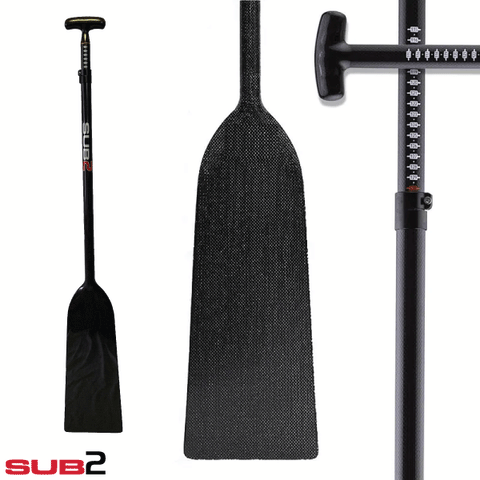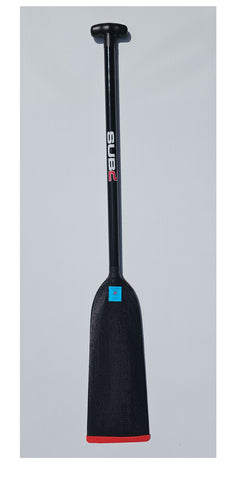Paddle Sizing
How to measure the right size paddle for you?
With so many paddles on the market today, it's already a headache to decide which one to buy, let alone determining which length is right for you.
In this quick guide, we will make finding your perfect fit seamless.
Note: This is a general guide based on a formula developed by a combination of dragon boat manufacturers.
Determine your ideal length through the following steps:
1. Sit upright on your buttocks on a flat surface (e.g. chair or bench)
2. Raise your right arm vertically upwards toward the ceiling.
3. Measure the length between your buttocks and the centre of your palm. (Please measure in centimetres to accurately use our measuring guide below.)

For a more specific measurement, consider the following factors:
1. Arm and Body Length
a. If your arms are longer than average then you should add one inch to the matrix size
b. If your arms are shorter than average then you should subtract one inch from the matrix size
c. If your torso is long, but your arms are average add one inch to the matrix size
d. If your torso is short, but your arms are average subtract one inch from the matrix size
e. If you have both long arms and long torso add one to two inches to the matrix size
f. If you have both short arms and short torso subtract one to two inches from the matrix size
g. If your arms and torso are average use the indicated matrix size
2. Boat Type
a. If you paddle in an IDBF Certified Standard boat (Swift, Champion, BuK, etc…) then use the indicated matrix size, no adjustment is necessary
b. If you paddle in a teak dragon boat or a dragon boat with very little freeboard (6-16) (the distance from the top of the gunwale to the water) then you should subtract 1 inch from the matrix size
c. If you paddle in a Taiwan style (flag grabbing) dragon boat or in a dragon boat with considerable freeboard then you should add 1 to 2 inches to the matrix size. More freeboard means you need a longer paddle.
3. Water Type
a. If you paddle in flat, fresh water (i.e. lake, calm river, reservoir, etc…) no adjustment necessary
b. If you paddle in flat, salt water (i.e. bay, harbor) your boat may have increased buoyancy. Add 0.5 to 1.5 inches to the matrix size
c. Rough water – such as wakes, waves and windy conditions on a regular basis, subtract one inch from the matrix size. Windy conditions may require a heavier paddle, such as wood versus carbon fiber
4. Position in the boat
a. If you REGULARLY sit in a particular bench you should adjust for the water height at that bench, for example if you are always the lead stroke or you always are in bench 7 then use the following adjustment factors if you do NOT sit in the same bench regularly or move around do not make the adjustment
i. Bench 1 subtract 1 to 2 inches from matrix size
ii. Bench 2 and 3 subtract 1 inch from matrix size
iii. Bench 4, no adjustment
iv. Bench 5,6,7 add 1 inch from matrix size
v. Bench 8 no adjustment
vi. Bench 9 and 10 subtract 0.5 to 1 inch size
1. Again – ONLY make these adjustments if you sit in one of these benches regularly
5. Crew Composition
a. If your boat is not full for most practices you may need a longer PRACTICE paddle, but a shorter RACING paddle.
b. If your crew is heavier than average you may need a shorter paddle, subtract 0.5 to 1 inch)
c. If you crew is lighter than average (i.e. Junior), add 0.5 to 1 inch
6. Stroke Rate
a. If your crew uses a fast stroke rate and you have trouble keeping up (more than 75 strokes per minute) subtract 1 inch
b. If your crew uses a slow stroke rate (less than 60 strokes per minute) and you feel you are not getting enough power add 0.5 inches
7. Stroke Set Up
a. If your coach has you bring your top hand above your head during recovery or your team uses a “high set up” then you may want a longer paddle. Add 0.5 to 1 inch
8. Personal Preference
a. Intermediate to advanced paddlers of average height use paddles that may vary from the matrix size indicated. There are many shorter paddlers who prefer longer paddles and taller paddlers with shorter paddles. The data for the expert paddlers is very solid, which may indicate that it can take many years to develop into the right size paddle.
9. Try before you Buy
a. The best method for selecting a paddle size is to try a paddle of that length during practice. Find someone with a longer and shorter paddle than the one you are using and ask to switch for a few minutes. If possible, have your coach evaluate your stroke with your normal paddle and then with the size you prefer.
b. When in doubt go a little longer. Novice paddler tend to need a shorter paddle so if you really are not sure what size to purchase go with the longer of the two. A paddle can usually be shortened but not lengthened.
c. Ask the company selling you the paddle what their return policy is. A reputable company will take back the wrong sized paddle as long as there is no visible wear or damage to the paddle.
This guide is copyright 2008 by Double Fifth Dragon Boating, please call or write for permission to reprint or post..



